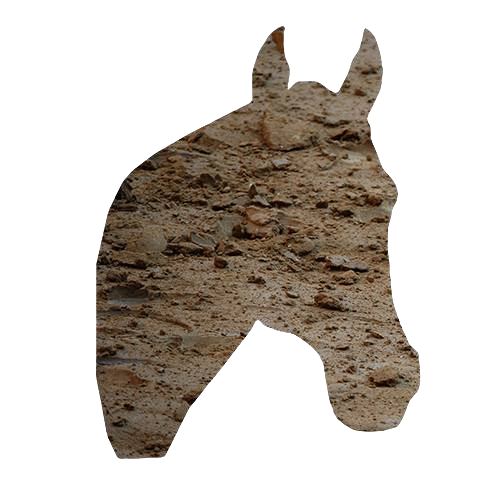www.thepalio.eu - dal Belgio con amore
The Palio
The Palio di Siena is a horse race that is held twice each year, on 2 July and 16 August, in Siena, Italy. Ten horses and riders, bareback and dressed in the appropriate colours, represent ten of the seventeen contrade, or city wards. The Palio held on 2 July is named Palio di Provenzano, in honour of the Madonna of Provenzano, a Marian devotion particular to Siena which developed around an icon from the Terzo Camollia. The Palio held on 16 August is named Palio dell’Assunta, in honour of the Assumption of Mary.
Sometimes, in case of exceptional events or local or national anniversaries deemed relevant and pertinent ones, the city community may decide for an extraordinary Palio, run between May and September. The last two were on 9th September 2000, to celebrate the entering of the city in the new millennium and on 20th October 2018, in commemoration of the end of the Great War.
A pageant, the Corteo Storico, precedes the race, which attracts visitors and spectators from around the world.
The race itself, in which the jockeys ride bareback, circles the Piazza del Campo, on which a thick layer of earth has been laid. The race is run for three laps of the piazza and usually lasts no more than 90 seconds. It is common for a few of the jockeys to be thrown off their horses while making the treacherous turns in the piazza, and indeed, it is not unusual to see riderless horses finishing the race.
Contrade
Siena has 17 city wards or contrade:
Aquila | Bruco | Chiocciola | Civetta | Drago | Giraffa | Istrice | Leocorno | Lupa | Nicchio | Oca | Onda | Pantera | Selva | Tartuca | Torre | Valdimontone
History of the Palio
Origins
Since 1200 there is evidence of a horse race in Siena. Older documents from the twelfth century speak of a “Palio di San Bonifacio”, the patron saint of the old cathedral, which had been erected in Castelvecchio before the present one. On the square in front of the current Duomo we can still see marks of the arrival line of a horse race. When Siena became one of the richest and most evolved cities in Europe in the Middle Ages, the Palio became an annual event in honor of the Madonna of Siena. The highlight was the Sienese offering candles, an act to reinforce their devotion to Our Lady Assumption (Assunta).
Since the 14th century the municipality has been appointing some “Deputati della Festa” (Delegates of the festival) to organize the festival every year. They have fixed duties and powers. The Palio was ridden between nobles and their horses. It was called “Palio alla Lunga”; a horse race through the streets of Siena that left at the gates of the city and ended in the square in front of the Duomo. The prize was a pallium, a long piece of precious cloth.
The oldest document about the Palio dates from 1238 and deals with a fine of 40 coins imposed on Bruno Ciguarde for ridiculing the opponent through the use of a pig’s head.
These first Palios, as stated, were held among nobles. The Contrade took part in raw battles to gain pieces of territory in the city. After all, Siena was built on 3 hills and the neighborhoods emerged on these three hills. At that time there were many more neighborhoods than now. After the plague (conquered in 1347) their number was reduced to 42. The names of the neighborhoods were derived from streets, houses, churches or very wealthy families who were on their territory. Each neighborhood had its own military unit, administration, church and provided relaxation for the residents.
The Renaissance
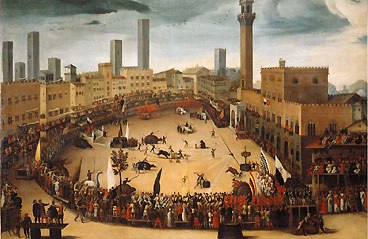
During the Renaissance, the days of the Palio were the moment for great aristocrats, prelates and European princes to descend to Siena. Since the gentlemen themselves had stopped waging war and were used to sending mercenaries to fight in their place, this happened in the same way with the Palio, but with fantini (jockeys). The Palio became a spectacle in which the men could show their abilities to find and pay a good jockey. However, the fall of the Republic of Siena in 1559 marked the end of the battle between families.
Other forms of battles started: Palios between neighborhoods, fistfights, bullfights, a kind of medieval football (pallonate) and races on buffeloes. Prior to these games, extras from the neighborhoods entered the Piazza, accompanied by floats with exotic animals or references to mythical events. A kind of Corteo Storico.
Firenze still organizes “pallonate”, better known as Calcio Fiorentina. There have been years that it was so violent that it was abolished.
Seventeenth century
In the first decades of the seventeenth century, the Palio evolved into a folk festival. The proposal to run the Palio on the Piazza is officially confirmed on July 11, 1605. A drawing by Bernardino Capitelli from 1632 shows the Palio ran on the Piazza. We see riders on horses without a saddle, the contradaioli stand in the middle of the square.
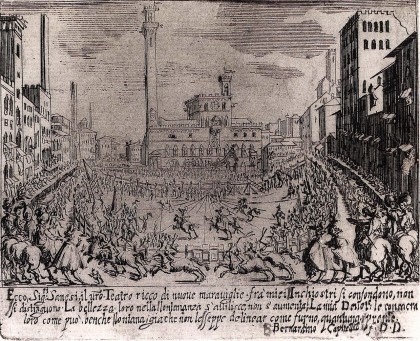
The Palio “alla tonda” (Palio in a circle) took place more and more often in the Piazza. Until the mid-century bufalate (races on buffaloes) were also still organized. From 1656, Palios were organized annually around July 2nd.
The fantini started playing an important role, they were considered mercenaries. In addition to a fixed salary, they were given the right to beg in the winning district. This custom was maintained until 1965 when Andrea Degortes (Aceto) put an end to this tradition because he refused to ask for a tip.
In the first Palios, the neighborhoods themselves had to take care of a horse. To distribute the odds more fairly, the horses were distributed from the Palio of July 2, 1676 through a lottery. From 1657 onwards there was ridden without a saddle and the winning jockey went to the Provenzano church with the contradaioli where the Te Deum was sung.
The tratta took place at Porta Camollia, just outside the city walls. The horses had to run from Palazzo Diavoli to the Chiesa di San Bernardino all ’Antiporto. Both the horse that won the race and the horse that came last were chosen. The Tratta became more and more important. It determined the order in which the procession (Corteo Storico) entered the square, as well as the starting order of the race.
Eighteenth Century
In the eighteenth century a second Palio was introduced, in addition to that of July. The idea came from Oca, winner of the Palio in July 1701. They wanted to set up a Palio in August in honor of their victory. They would, as required by the rules, be responsible for the costs and payment of the winner. They chose August 16, the day after Ascension Day. In 1774 the city council decided to bear the costs and organization of a second Palio.
They also made rules. On 16 May 1721 the “modern” regulations of the Palio were voted. The hours of tratta, practice rides, etc. were set down in this way. Agreements were also made about the preparation of grandstands, the way in which the Corteo goes out, the amount of premiums for the winner, … A second important decision was that of Violante Beatrice di Baviera, the governor of Siena who established the boundaries of the neighborhoods in 1729 and put an end to territorial disputes.
Since 1761 the Tratta has been organizes in the city, at the Porta di Biccherna. Fantini and horses were rarely of noble descent. Among the riders there was a bitter rivalry that often ended in threats and fights. An excellent example of this is Isidoro Bianchini detto Dorino, who won 13 Palios for nine different neighborhoods. He had a fight with just about every other fantini of that time. During the race of July 2, 1788, such a rivalry ended almost fatally. Dorino and Ciocio already started banging each other with the whip. They fell off their horse. But the fight continued on the ground. The security forces had to intervene to prevent worse (murder). Both fantini end up in prison where they were fired the next day.
Nineteenth century
Important measures were taken at the beginning of the nineteenth century. First of all, it was decided that before the actual start (read the falling of the cord) it was NOT allowed to hit the whip on anything other than the own horse. In addition, the cash price, which until then was only given to the winner of the Palio alla lunga (15 August), will be distributed. For example, the winner of the Palio alla lunga receives 70 coins and the winner of the Palio on the Piazza 40. The silver bowl that is mounted above the banner must be returned to the city. This is seen as the “plate” from which the rider and the horse must eat together during the victory celebration. The pole on which the palio hangs goes according to tradition to the captain of the neighborhood. The owner of the winning horse receives a fixed amount from the City.
The colors of the neighborhoods were laid down in 1845. When a few years later Italy became one, Aquila continued to choose the yellow-black colors and the double eagle, a tradition going back to the visit of Charles V. During the Risorgimento (unification of Italy) Tartuca changed colors under pressure. The yellow-black, which resembled the colors of the Austro-Hungarian empire changed to black and white, which was a tribute to Pope IX. Two years later, it became yellow-black again, which resulted in booing from the other neighborhoods. In 1859 they put an end to it by choosing blue-yellow. Oca was better off, the colors chosen in 1791 (green-red and white) corresponded perfectly with the new Italian flag!
The fantini in the nineteenth century were best known for their shameless betrayal. Francesco Santini (Gobbo Saragiolo) drove during his 30-year career for no fewer than 15 neighborhoods (he won for 7 different ones). In 1855 he deliberately rode his horse (top favorite) out of the square into Via San Martino. When people asked afterwards why this happened, he replied: “Why would I win for 140 coins if I could lose for 170.” It happened a lot that fantini on horseback rode down the Piazza during the race (in San Martino or Casato) in order to to flee far beyond the walls of the city.
Twentieth century
At the beginning of the twentieth century, the town and the costumes of the Corteo Storico were renewed. In 1904 it was decided to dress the extras in a medieval style. The “sbandierata della vittoria” was introduced in 1919. Each neighborhood delegates 1 tamburino (drummer) and 1 alfiere (flag-waving). The 17 neighborhoods then wave together, one time in a row with the flag before the horses leave the town hall. This is still happening now.
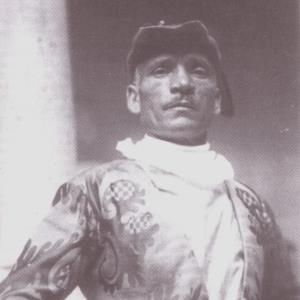
One of the most important fantini of the new century was Angelo Meloni (Picino). He became one of the greatest of all time: he participated 52 times in 15 different neighborhoods. He won 13 times. His dominance, however, was tempered when in 1907 (out of fear of collaborations between fantini) it was forbidden that two fantini who were blood relatives (up to the third degree) rode along. This rule, by the way, remained in force until 1972. At one point, Picino stopped to give his son (Meloncino) the chance to participate. He won twice. The beginning of the century was also dominated by Scansino (7 wins) and Bubbolo who won 4.
No Palio was organized between 1915 and 1918 because of World War 1. With the rise of fascism and the colonial period, a Palio dell ’Impero was riden in 1936 (won by Giraffa). Between the two world wars, costumes were changed again. They chose a style typical of the late fifteenth century.
In the 30s of the 20th century there was talk of the T.O.N.O., a solid alliance between Tartuca, Oca, Nicchio and Onda.
The alliance started in 1927 with the victory of Nicchio in August. The first major successes were achieved in 1928. Oca won in July, Nicchio in August and Onda won the straordinario in September. In 1930 the success continued; Onda won in July and Tartuca won the August Palio. In 1931 Oca won, in 1932 Onda and Nicchio. In 1933 the unthinkable happened : Tartuca won the Cappotto (both races) with the legendary Folco.
A year later, in 1934 the alliance came to an end when Oca won in August. In fact Nicchio who had a better horse had to lose because of made agreements.
Between August 1927 and 1934, 16 Palios were disputed. T.O.N.O. won 3 + 3 + 3 + 3 = 12 respectively. The rivals none at all.
The contrada-life and the Palio were interrupted by the Second World War. To celebrate the end of the war, a Palio Straordinario was organized in 1945, known as “Palio della Pace” (Palio of Peace). It became one of the most turbulent in the history of the Palio. Bruco, who wanted to win at all costs, had bribed everyone, including the mossiere. Rubacuori, Drago’s fantino, however, thought differently. He won. What followed was a real battle in which the Brucaioli destroyed the drappellone (banner) and several Dragaioli hit the hospital. Bruco was obliged to pay for the repainting of the Palio/drappellone.
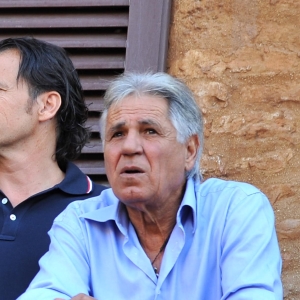
In 1945 the career of Giuseppe Gentili (Ciancone) started. He won no less than 9 Palios between 1946 and 1969, despite being banished by Oca for 4 years because he was suspected of being bribed by enemy Torre during the victory of 1961. The post-war years also brought another top fantino: Giorgio Terni (Vittorino). He won no less than 6 races in 21 ran. On August 16, 1957, for the first (and last) time a woman ran the Palio: Rosanna Bonelli (Rompicollo). The great ruler of the post-war period is undoubtedly: Andrea Degortes (Aceto) who won no less than 14 times and was nicknamed “Re della Piazza”. Il Pesse (9), Cianchino (8) Bazza (6) and Il Biondo, Tristezza and Bastiano (all 5) also colored the second half of the twentieth century.
The best horses in this period were Uberta de Mores who won no less than 4 consecutive races, Topolone (winner of 7 Palios) and Panezio (8 in a career of no less than 13 years). Urbino de Ozieri, who won 3 of her 4 races, was forced to retire early because of superiority.
2000 until now
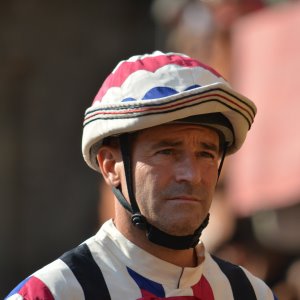
The new millennium is characterized by the dominance of Luigi Bruschelli (Trecciolino), who so far has won the Palio 13 times (10 since 2000). Giovanni Atzeni (Tittìa) , 10 victories and Andrea Mari (Brio) with 6 wins follow. Jonathan Bartoletti (Scompiglio) is also a protagonist with 5 Palio’s. Alberto Ricceri (Salasso) and the already stopped fantino Luca Minisini (Dè) won 3. Multi-winners among the neighborhoods are Selva (no less than 6x), Tartuca (5), Giraffa, Onda and Leocorno (4) and Bruco, Istrice and Drago and Oca with 3 .
Modern Palio life mainly takes place at specific locations: the oratarium (the chapel where religious ceremonies such as the blessing of the horse take place), the “Societa di Contrada” (the ward) and the fontanine (baptismal fountain of the neighborhood). Every Contrada also has a museum. Parent-to-child membership is also arranged differently. People used to get married within the neighborhood so there were no discussions. Nowadays we see marriages between people from different contrade. For parents of two different contrade, the membership of the children is carefully negotiated, taking into account the influences and relationships of both parties and the importance of the Contrada in the lives of each of the parents.
The race
The participants
The race takes place on the central square of Siena, the Piazza del Campo. 10 of the 17 contrade participate in every Palio. These are chosen by luck according to a well-thought-out scheme based on constant rotation of participants: the 7 neighborhoods that were not allowed to participate in the Palio in July the year before run the Palio anyway. The 3 others are drawn from the 10 that did participate. The same arrangement applies for August. Note: the Palios of July and August are separated from each other. The draw takes place on the last Sunday of May (July-Palio) and the first Sunday after the Palio of July for that of August. After the 3 participants have been drawn, the other 7 are also drawn. On the one hand to determine the order of the following year, on the other hand for the Corteo Storico. With a Palio Straordinario, things are different: 10 participants will be drawn.
The phases of the start
In the afternoon before the race the neighborhoods walk through the City in medieval costumes. And they gather at the Duomo to make their entrance on the Piazza.
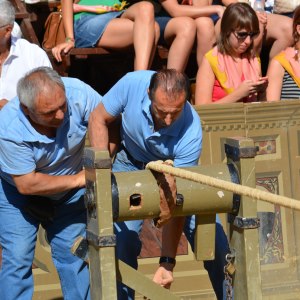
After the Corteo Storico (at 7.30 p.m. in July and at 7.00 p.m. in August) the fantini leave the courtyard of the town hall (Entrone) on their horse. They receive a whip from a police officer and go to the mossa (start). Two ropes hang at the Costarella. The rear rope is shorter than the front, creating a kind of “gate” (Verrocchino). The starter (mossiere) calls in 9 neighborhoods. This order is drawn a few minutes before the start. The 10th and last horse determines when to start. When he enters the “gate” with the nose of the horse, the starter drops the front cord and the race starts. So it is not the mossiere that determines the start.
During this phase of the race, fantini will determine or adjust the strategies according to the starting position they have drawn. The 10th (rincorsa) and last will be approached by just about every neighborhood to give a favorable start to that or this neighborhood. Or just a bad one on the rival. At that moment there is a lot of money going on between the fantini. Of course, the 10th also received an order from his neighborhood. The start can therefore be delayed for a long time or, in the worst case, delayed until the following day, when everything start where it ended the previous day. The last time this happened was on July 2, 1991.
Neighborhoods that do not participate can also play a role in the starting procedure, certainly when rivals are involved in the game.
The Race
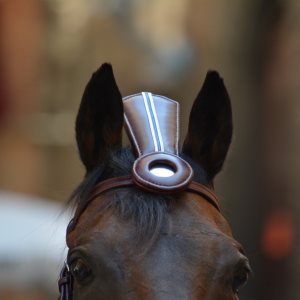
Once the rincorsa enters, the course starts. The Palio is won by the horse, with or without a jockey, who first reaches the finish line (indicated by the bandierino (flag)) after three rounds around the square. If the horse arrives without a rider, it is called a “scosso”. The riders wear the colors of the neighborhoods in their uniforms. The horse has a “spennacchiera” on his head in the colors of the neighborhood.
After the victory, the contradaioli of the winning district go to get the drappellone at the starting line where it is displayed next to the captains and delegates of the city. The bring the drappellone to the Chiesa di Provenzano in July to sing the Te Deum to thank Maria. In August they go to the Duomo for the same ritual. The weeks and months after the victory they celebrate. The Palio (banner) will be stored in the museum of the neighborhood.
Palio throughout the year
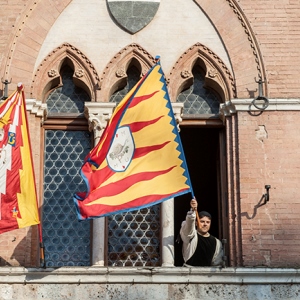
Although there are numerous activities taking place within each Contrada, the organization of the Palio remains the most important. It is also not only the 2 races that matter. Contrade prepare themselves for an entire year.
The district administration already starts preparations in the winter. They keep in touch with fantini and horse owners. After all they train the horses that will race during the Palio. So they regularly look at small courses in the province or sometimes show their faces during training. The city of Siena nowadays also organizes courses on a specially constructed slope outside the city.
The Palio season starts at the end of May. On the last Sunday of May, it is the “estrazione” (draw of the 3 neighborhoods that will also participate in July). After this ceremony the captains and mangini will start with the real preparations. They establish contacts with riders and draw up strategies, despite the uncertainty of a top horse.
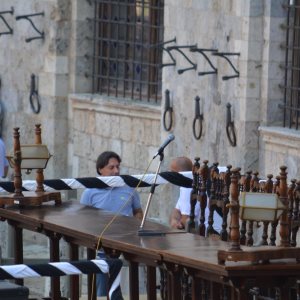
The drappellone is presented about a week before the Palio. In July the banner is created by a local artist. In August it is usually an internationally recognized artist. The horses are also inspected by the city’s veterinarians during this period.
On the first day (29 June or 13 August) of the four-day festival, the “Tratta” takes place. At that time, the neighborhoods are assigned their horses by draw. In the presence of the 10 captains and the mayor, 10 numbers (corresponding to the horses) are put into an urn. The 10 names of the participating neighborhoods are located in a second urn. Two children dressed as pages link a number to a contrada.
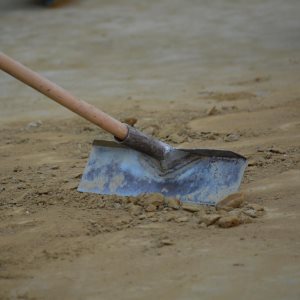
On the Piazza del Campo there is a slope made of Sienese tuff (combination of clay and sand). 6 proofs (practice rides) are ridden on which the fantini get to know their horse better. You can follow this in the middle of the square, together with contradaioli and tourists. On the outside there are stands arranged against the houses.
The evening before the race, a supper takes place in each participating neighborhood. In the presence of the district management and the rider, hundreds, sometimes thousands of people eat together, depending on the size of the neighborhood. The morning of the race on the Piazza the “Messa del fantino” is organized. Hereby the bishop blesses the fantini for a safe and secure course. In the afternoon, the horse is also blessed in the neighborhood itself. At 11 am the captains and their fantino are expected at the town hall to register their rider for the race. Fantini participating for the first time get their nickname. After this registration you can no longer change your fantino.
For a detailed overview day by day, please refer to our timetable.
Palio Straordinario
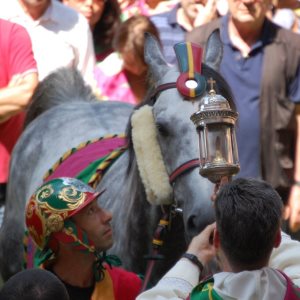
The Palio Straordinario is held in the period between May and September, and is linked to events or birthdays of general interest for the Sienese. The last one was organized to remember the end of the Great War 100 years ago. On October 20, 2018, Selva won with Tempesta on Remorex. The previous one was in honour of the holy year 2000. The eighteen years was the longest period between 2 straordinarii of the last two centuries. Only between 1928 and 1945 was it longer to wait because of the war.
In the early years of the Palio, a third Palio was set up to celebrate a visit or transit of an important guest. For example, a Palio Straordinario was organized on 7 June 1676 on the occasion of the visit of Prince Don Agostino Chigi. Often an extra Palio was driven the day after the regular.
Since the Second World War, no fewer than 11 Palii Staordinarii have been driven. And this for the most diverse reasons. (actually every reason was a good one to organize one)
- August 20, 1945 – the infamous Palio della Pace after the end of the Second World War
- May 18, 1947 – for the 600th anniversary of the birth of St. Caterina of Siena
- May 28, 1950 – for the 500th anniversary of the canonization of San Bernardino of Siena
- September 5, 1954 – for the celebration of Maria’s year. Siena calls itself “La Città della Madonna”
- September 4, 1960 – for the 600th anniversary of the mythical battle of Montaperti, in which a Gibbelinian-Sienese Army defeated a Welfish-Florentine Army. A battle of a fairly large dimension for that time.
- June 5, 1961 – for the celebration of 100 years of Italian unity.
- September 24, 1967 – for the 49th Congress of the Società Italiana per il Progresso delle Scienze, decorated in Siena. Probably the most ridiculous reason to set up a Palio, but a third Palio was already 6 years ago.
- September 21, 1969 – for the first man on the moon.
- September 17, 1972 – for the 500th anniversary of Monte dei Paschi di Siena, the oldest active bank in the world.
- September 7, 1980 – for the 600th anniversary of the death of St. Caterina of Siena.
- September 13, 1986 – for the 200th anniversary of the Comunità Civica or Civil Community
At the end of the 1980s in Siena, people began to realize that a Palio Straordinario had become a risky venture for 3 reasons. First, the contrade could no longer cope financially. The costs, and especially the contracting of top riders, had completely got out of hand. A third Palio had become too much for the contrade budget. Secondly, the city was also a bit worried about the considerable costs of organization. Thirdly, Siena slowly but surely began to attract the negative interest of all kinds of animal protection organizations, which, incidentally, started making inappropriate comparisons with the corrida. The media were very happy that a new big can of sensation had been opened and took a strong part in the polemics, never disturbed by any knowledge of the matter. As a result, the city council saw danger in a third annual “defying fate”.
After the Straordinario of 1986 it took until 2000 before a third Palio was set up again for the new century. In 1990, the city even refused to set up a Straordinario for 750 years at the University of Siena (1240-1990) to the great dismay of the rector and astonishment of the population.
In 2018 a new Straordinario was held to remember the end of World War I, exact 100 years ago.
Giustizia paliesca
Despite the fact that a lot is allowed during the Palio, there are regulations with no less than 105 articles.
There are 3 types of punishment that can be given to contrade depending on the size of the violation.
- Censura: applies to the following 5 Palios. When a neighborhood within these 5 Palios receives 3 Censura, 1 deplorazione follows.
- Deplorazione: applies to 9 Palios. When a neighborhood within these 9 Palios receives 2 Deplorazione, 1 esclusione follows.
- Esclusione (disqualification): applies for a limited time of a maximum of 10 years. Esclusione was only introduced after the Second World War. Neighborhoods were almost never punished for this.
Summary :
- 4x Censura = 1 Deplorazione (within the 5 Palios)
- 3x Deplorazione = 1 Esclusione (within the 9 Palios)
Penalties are only pronounced in the autumn, after the 2 Palios. However, they do give penalties for each Palio seperatly.
(Other) penalties are also imposed on the fantini.
- Ammonizione (warning): applies to 3 Palios. After 2 ammonizioni the Fantino gets an Esclusione. Note: 3 Palio’s = 3 Palio’s driven by him.
- Esclusione (disqualification): can be for a limited time but also for life. An exclusion applies to both tratta / prove and Palio itself.
History of penalties
The first disqualification of a contrada in the history of the Palio dates from 20 August 1945 when Tartuca and Bruco were suspended after the Palio della Pace to celebrate the end of the world war. It became one of the most violent of all time. Tartuca was disqualified because they decided not to participate after two debatable false starts. Bruco, on the other hand, because the contradaioli misbehaved after the Palio and, out of anger (because of the loss), had destroyed the drappellone won by Drago. However, the penalties were withdrawn because some time later it was felt that the party should be and remain because the war was over.
So we have to go to August 1966 for the first real disqualification of a Contrada. Valdimontone was disqualified for organizing an invasion of the track during a practice ride due to the improper arrest of 2 contradaioli. Torre was also disqualified because they too took the track the day of the Palio. They broke off the mattresses and pulled the cords because their rider had fallen at a false start and was unable to ride. Since you cannot replace a fantino after you have registered it at 11:00 am, they were “excluded” from the race. The contradaioli disagreed.
There were no new suspensions until 1973 when Istrice was suspended for 1 palio. The most severe punishment ever for a Contrada was also for Istrice in 2002. They were excluded from 4 Palio’s for turning off the fantino of Lupa (the rival notabene), Il Pesse, for not complying with agreements. The 6 attackers were also arrested.
In 1877 a fantino was suspended for the first time. Girocche got two years because he was drunk on a horse during the race.
In 1896, Ansano Giovannelli (Ansanello) also received a two-year suspension for not completing the three laps. He had betrayed his own neighborhood (Torre) by stopping in the last Casato, getting off and giving his horse to a police officer. That way he let Oca (the rival!) pass and win.
The first rider who was suspended for life was Angelo Innocenti. He was suspended on July 2, 1877, without ever having driven the Palio. Despite a false start, he kept on driving and pretending to have won. The ocaioli started to party with riots as a result. The palio was driven again the next day, without Angelo Innocenti.
Since WWII, many riders have been disqualified, mostly for irregularities and disruptions to the starting procedure. The most severe punishment was imposed on Franco Casu (Spirito) and Maurizio Farnetani (Bucefalo). They each got 20 palios! The first held Massimo Coghe (Massimino) by his sweater at the start of the Palio in August 1996. The second hindered Trecciolino in an unprecedented way during the Palio of August 1997. The last severe punishment was given for the Palio of July 2, 2015, when Massimo Colubu (Veleno II) pulled Nicchio’s Giovanni Atzeni (Tittia) from his horse during the race. He received 10 Palio’s suspension.
Stats
Victories per contrada
| Contrada | 1600 | 1700 | 1800 | 1900 | 2000 | Total |
|---|---|---|---|---|---|---|
| Aquila | 0 | 7 | 6 | 11 | 0 | 24 |
| Bruco | 6 | 7 | 16 | 5 | 3 | 37 |
| Chiocciola | 4 | 19 | 14 | 14 | 0 | 51 |
| Civetta | 2 | 7 | 15 | 8 | 2 | 34 |
| Drago | 2 | 8 | 9 | 16 | 4 | 39 |
| Giraffa | 3 | 5 | 9 | 15 | 4 | 36 |
| Istrice | 4 | 10 | 15 | 9 | 3 | 41 |
| Leocorno | 3 | 3 | 11 | 10 | 4 | 31 |
| Lupa | 1 | 11 | 11 | 11 | 3 | 37 |
| Nicchio | 5 | 10 | 11 | 16 | 0 | 42 |
| Oca | 8 | 14 | 20 | 20 | 4 | 66 |
| Onda | 3 | 9.5 | 14 | 11 | 4 | 41.5 |
| Pantera | 3 | 6 | 7 | 9 | 1 | 26 |
| Selva | 2 | 11 | 6 | 14 | 7 | 40 |
| Tartuca | 3 | 11.5 | 17 | 12 | 5 | 48.5 |
| Torre | 6 | 12 | 20 | 5 | 2 | 45 |
| Valdimontone | 2 | 16 | 10 | 15 | 1 | 44 |
Multiple winners amoungst fantini
Two fantini share the record in terms of the number of Palios won. These are Mattia Mancini (Bastiancino) and Francesco Santini (Gobbo Saragiolo): they both won 15 times. Bastiancino won for nine different neighborhoods between 1759 and 1779; Gobbo Saragiolo won between 1823 and 1853.
They are followed by three riders with 14: Pavolo Roncucci (Pavolino), Nicholas Chiarini (Caino) and Andrea Degortes (Aceto). Aceto is the record holder of the fantini of modern times. (Pavolino ran in the seventeenth century, Caino in the first half of the nineteenth century).
Five riders have 13 victories: Isidoro Bianchini (Dorino) (who won 5 Palio’s in a row, a record!), Pietro Locchi (Paolaccino), Mario Bernini (Bachicche), Angelo Meloni (Picino) and Luigi Bruschelli (Trecciolino).
Other fantini who have won Palio more than 10 times are: Giuseppe Galardi (Pelliccino) who won 12 or 13 times. Simone Pulcinelli (Mone), Francesco Ceppatelli (Tabarre) won 11 times. Tomasso Felloni (Biggeri) and Giovanni Atzeni (Tittia) were each 10 times successful.
Controversy and equine security measures
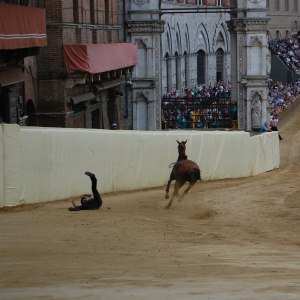
For several years, the Palio has been the focus of numerous protests by animal-rights organizations, including the Anti-Vivisection League. Concerns include primarily race incidents causing falls, which in some cases have led to horses’ deaths.
In 2011, these concerns resulted in Italy’s tourism minister blocking the Palio from being nominated for listing in the UNESCO Intangible Cultural Heritage Lists.
The results of calculations on the percentage of accidents caused by the Palio vary depending on who makes them. According to the Anti-Vivisection League, a total of 48 horses have died from 1970 to 2007, an average of one dead horse per year. However, the calculations carried out by supporters of the Palio for the same period, which include all the tests held before the real race, give a rate of 2.05% of fatal accidents per ride.
Many rules governing the protection of animals have been developed and implemented only since the 1990s; supporters of the Palio stress that injuries have been drastically reduced since then.
In recent decades, the city of Siena has adopted a series of measures to ensure the protection of horses (and riders) before, during and after the race, but these measures are still judged insufficient by some animal welfare groups, who continue to seek abolition of the race. Among the measures taken include:
- A compulsory health check held by a commission appointed by the City Council and consisting of two surgeons
- Serum chemistry analysis, introduced in May 1999 in order to confirm and verify what has always been required by the Rules, or the prohibition of administration of substances with stimulants and depressants and local anesthetics
- Approval in 1999 the “Protocol for the provision of incentives for the maintenance of the Palio horse” and the establishment of the register of horses trained to run. A register of farmers was introduced in 2004, instead of half blood Arabian horses (deemed physically fit to travel) and a register of barriers
- Building a track in the town of Mociano, identical in shape and slope to the Piazza del Campo. From March to June, in addition to Monticiano and Monteroni d’Arbia, the horses intended for the Palio train here.
- Protections (formerly known as materassoni) present the curve of St. Martin in June 1999 set up a barrier of protection to high absorption in PVC, raising the parapet of the House and the curve of shirts introduction of safety for the emergency personnel of 118
- Intervention on the composition, method of implementation and monitoring of the layer of tuff
- Care of horses that no longer run the Palio (due to age or injury) at the Equestrian Center of State Forestry, “The Caggio”, in the town of Radicondoli.
- Alcohol test for jockeys by order of the Secretary of Health Francesca Martini.
Glossary and timescedule
For an extensive glossary, please refer to our ‘dictionary‘.
A daily schedule can be found here.
Last update : 3 july 2024
